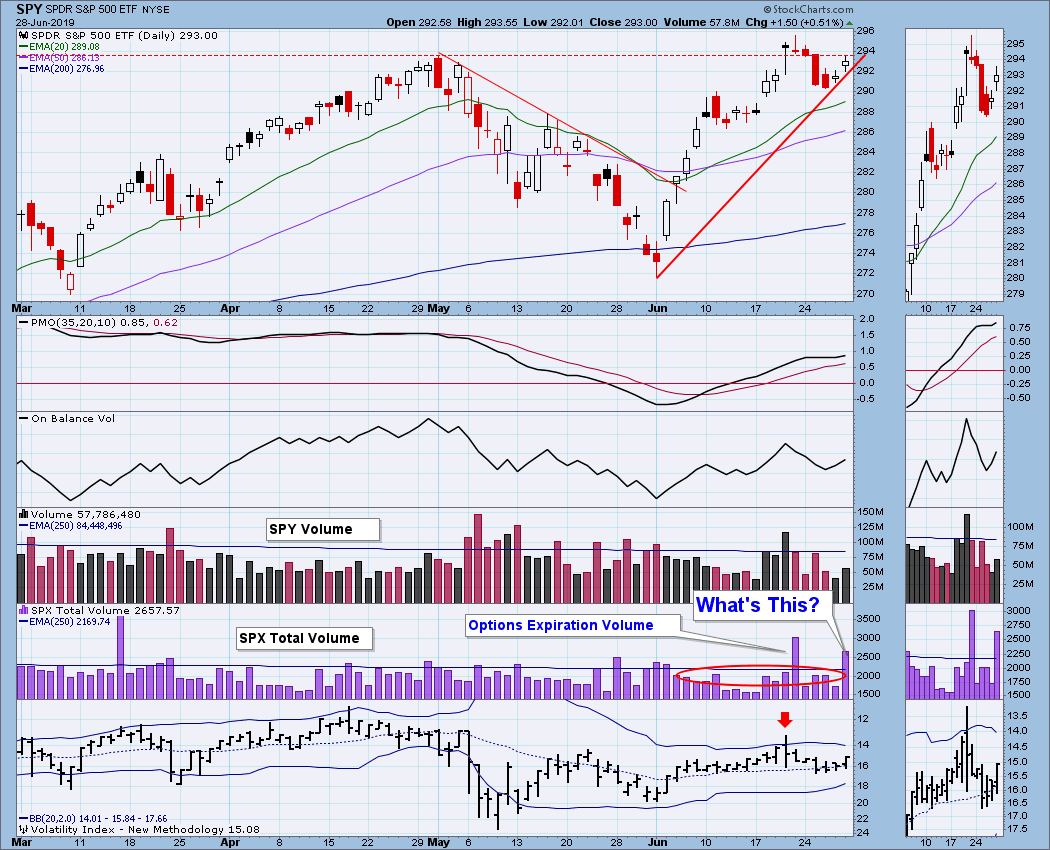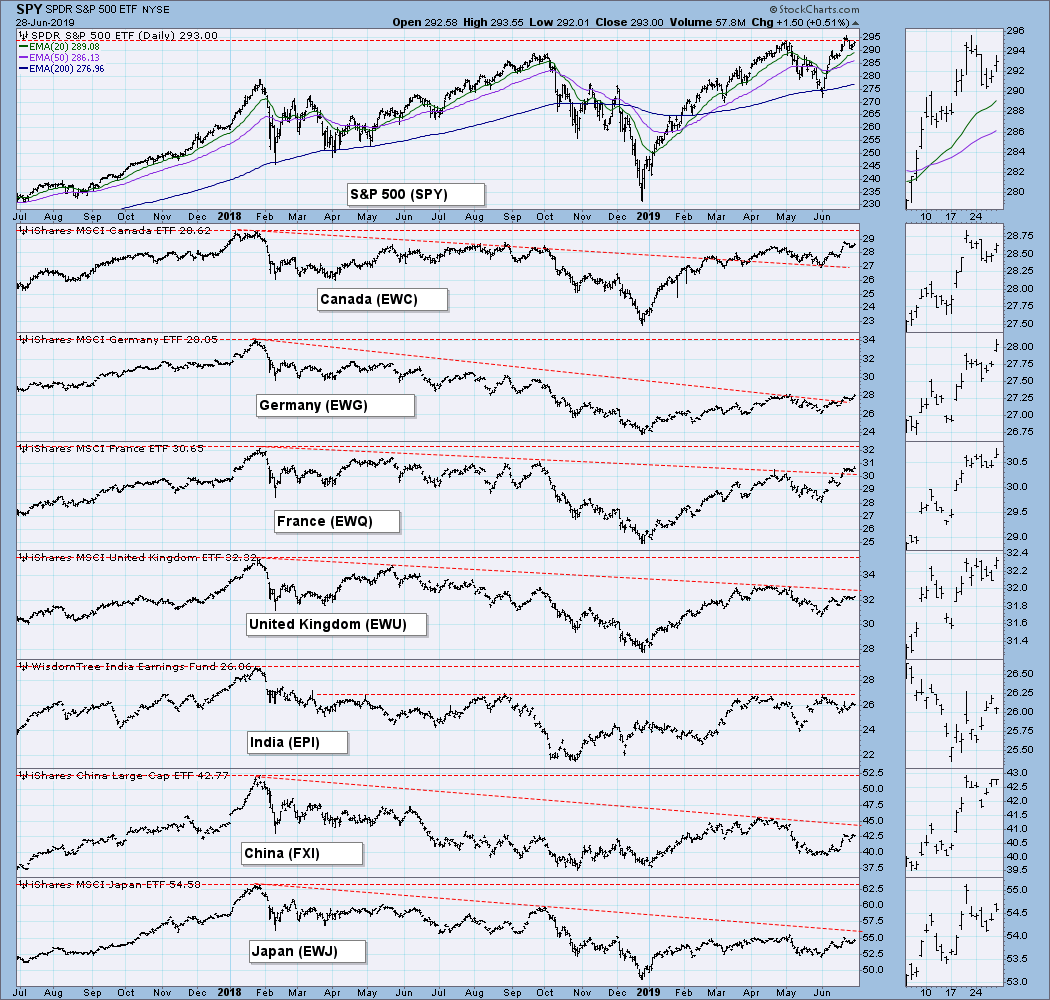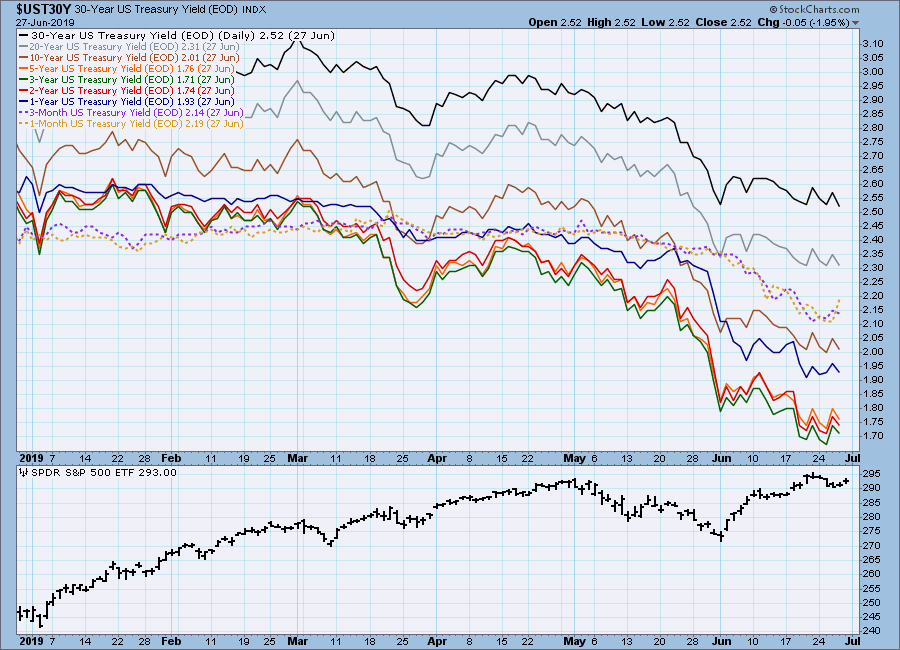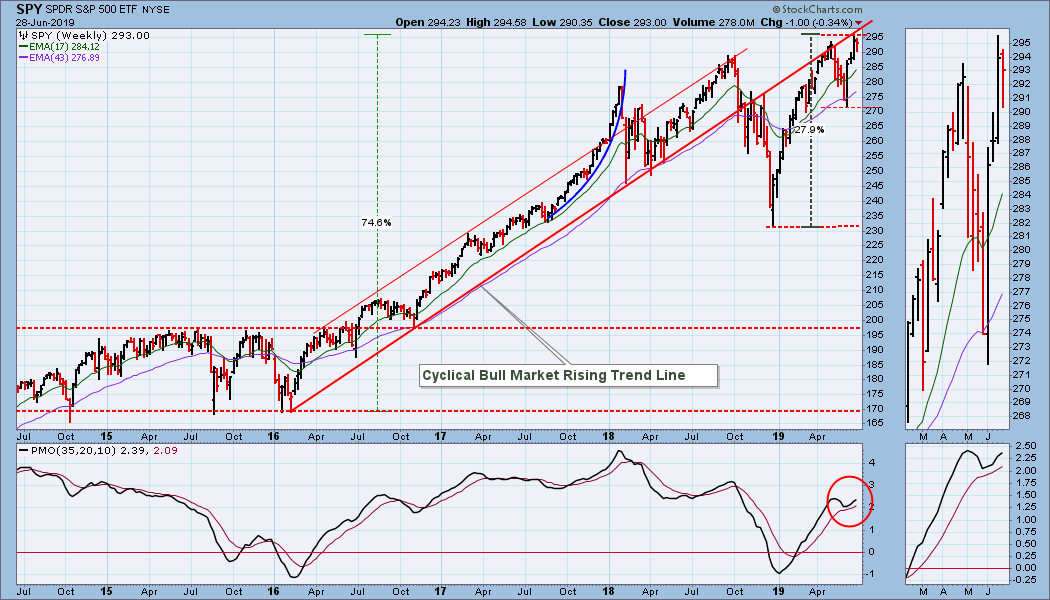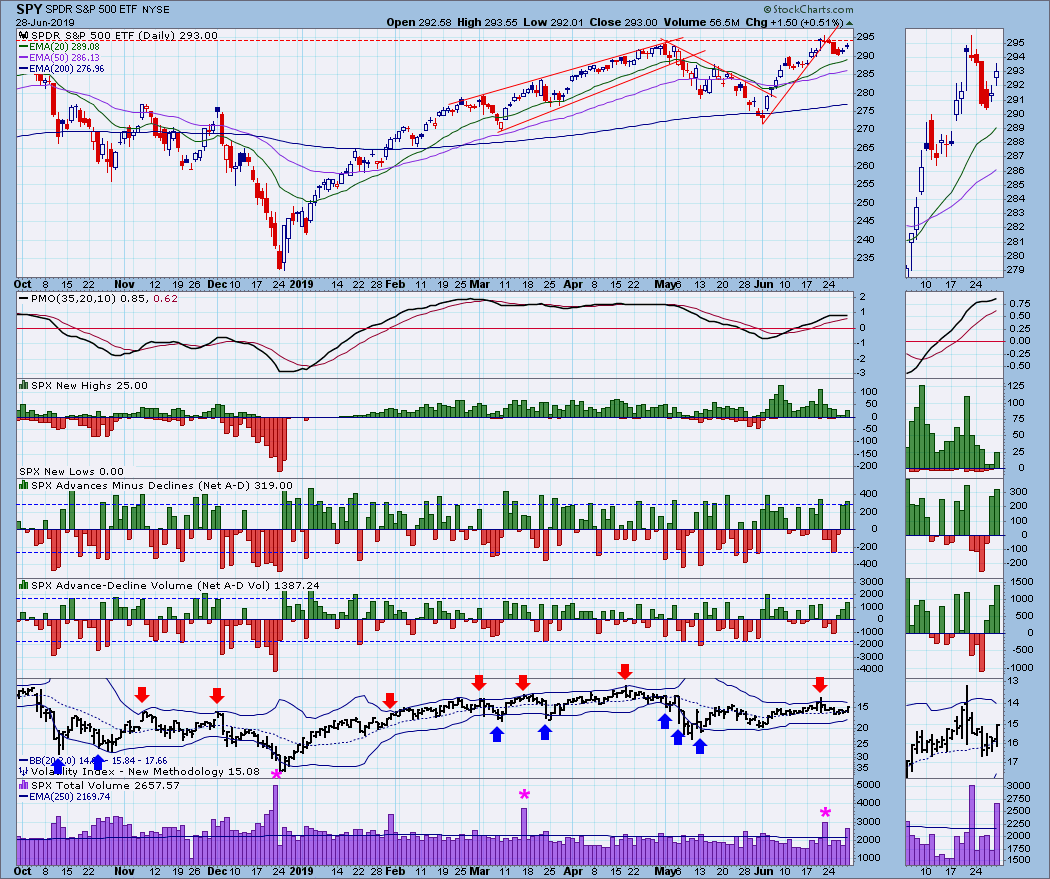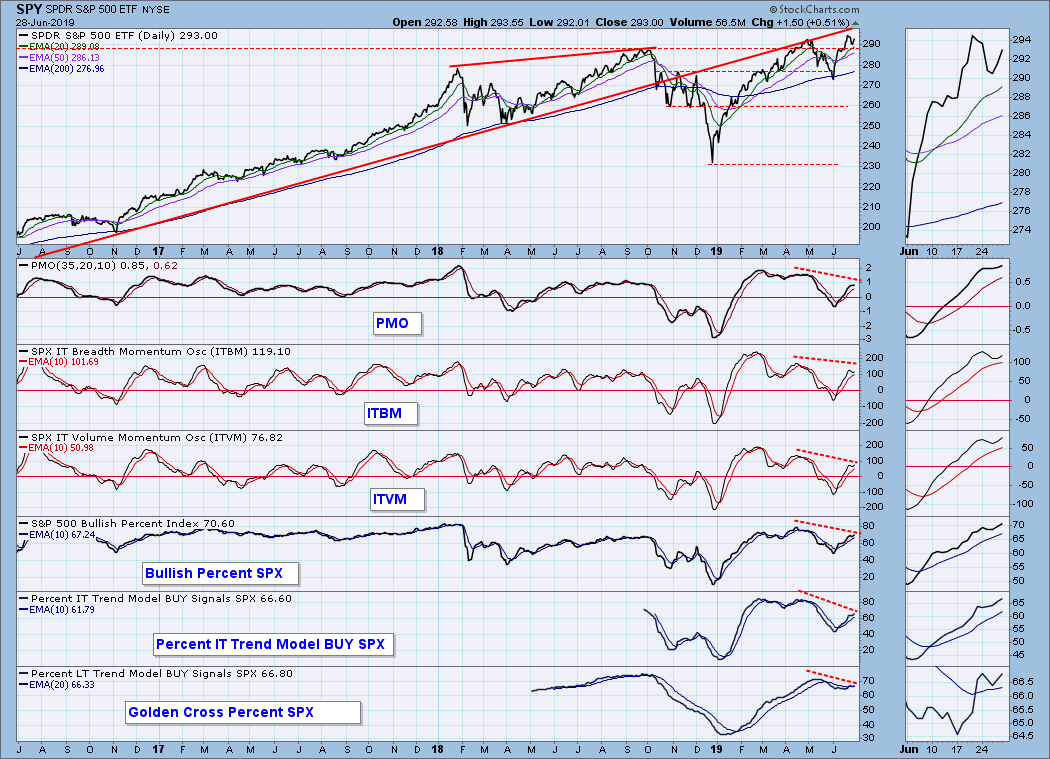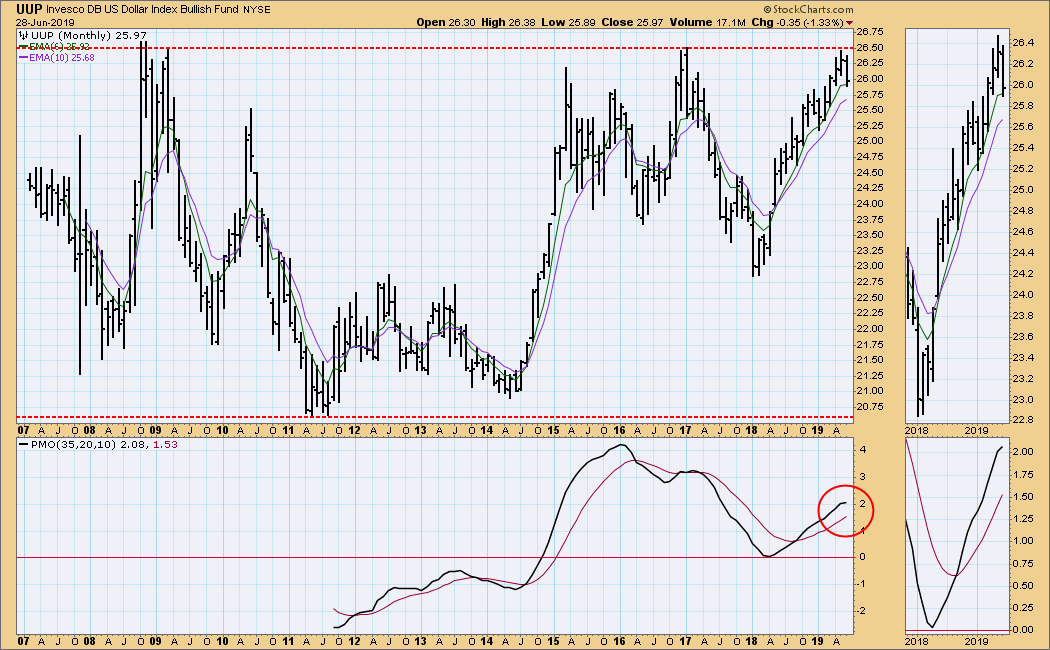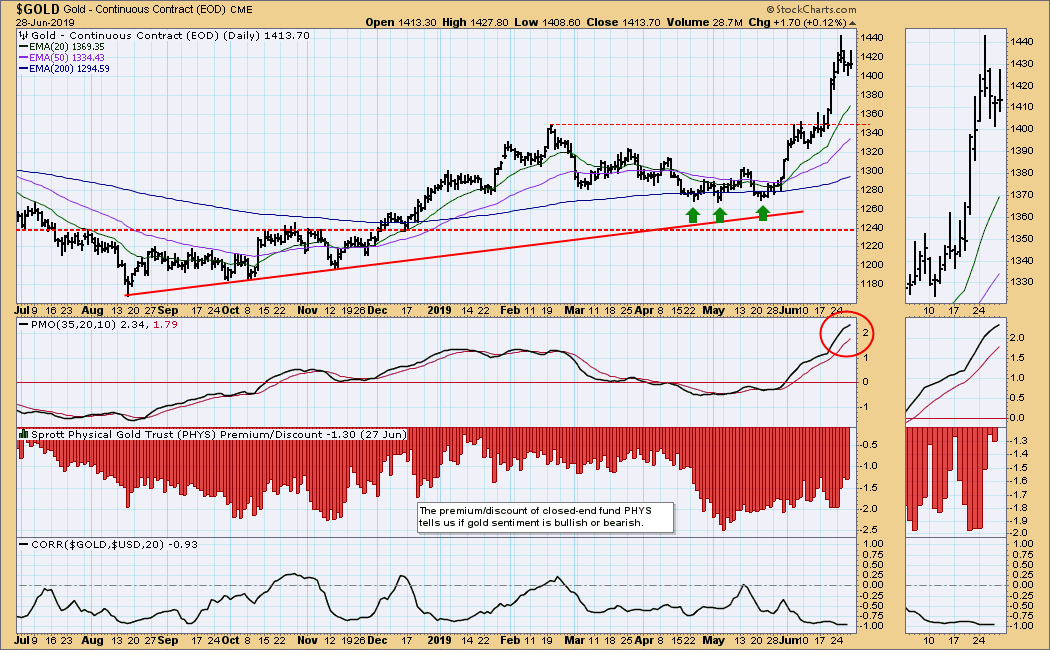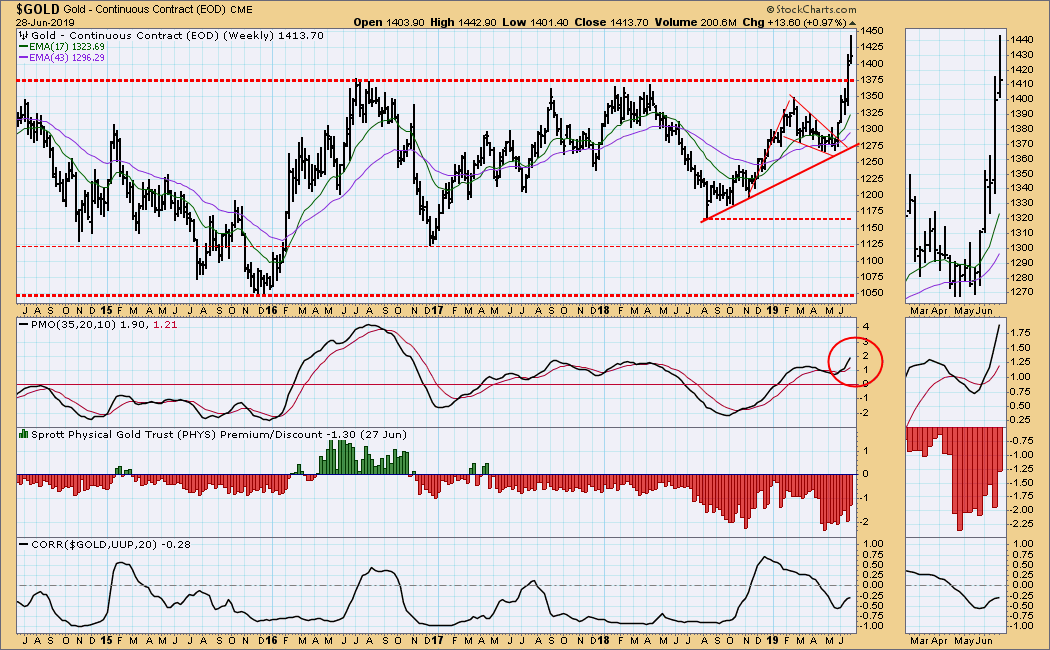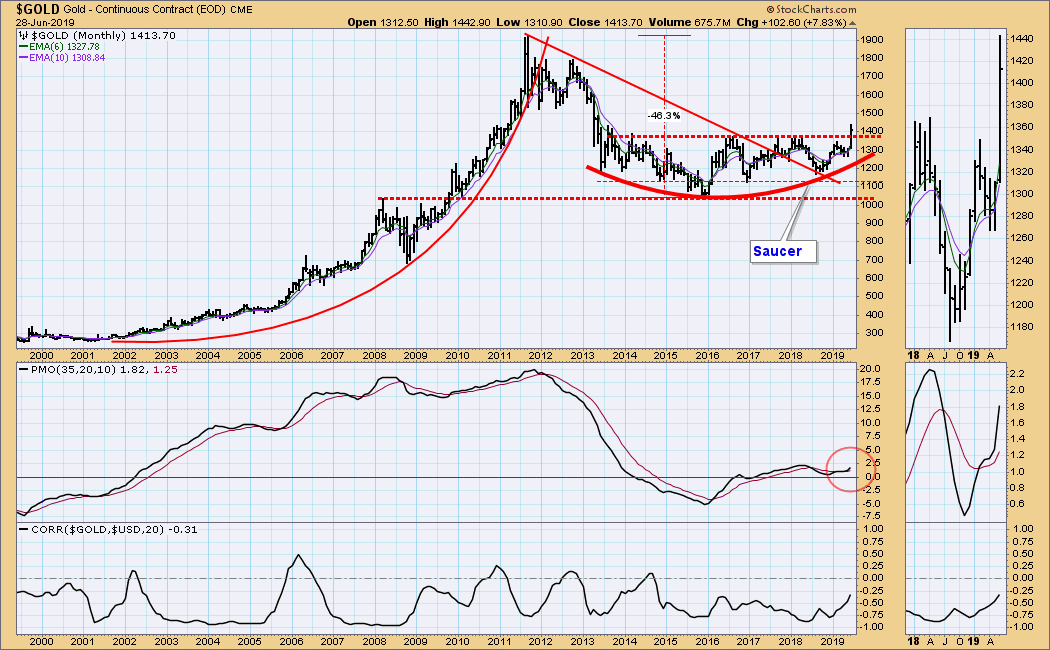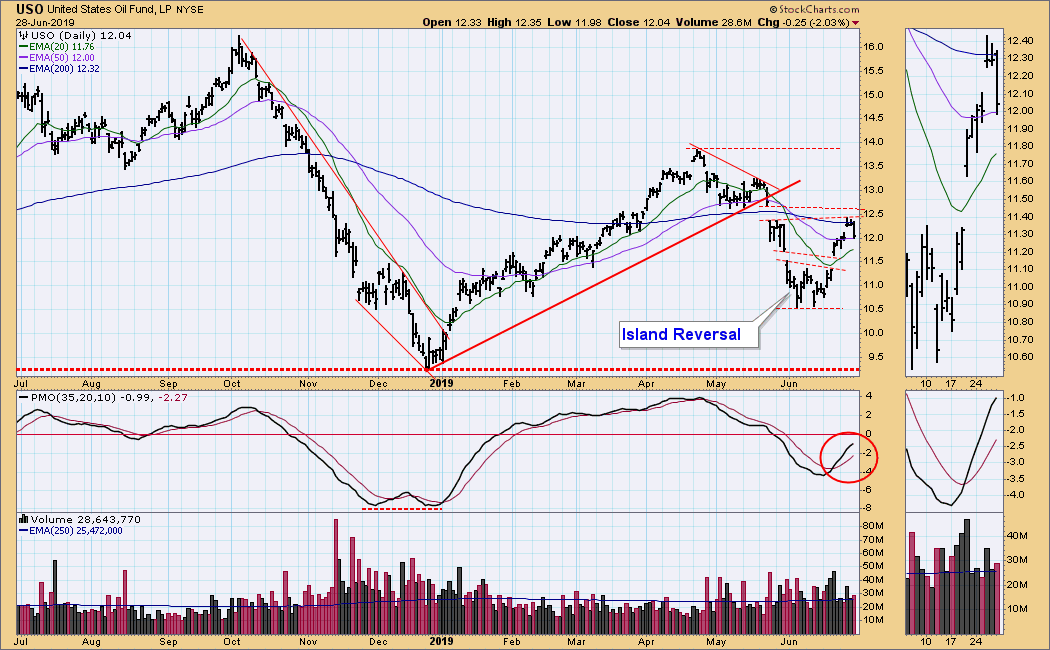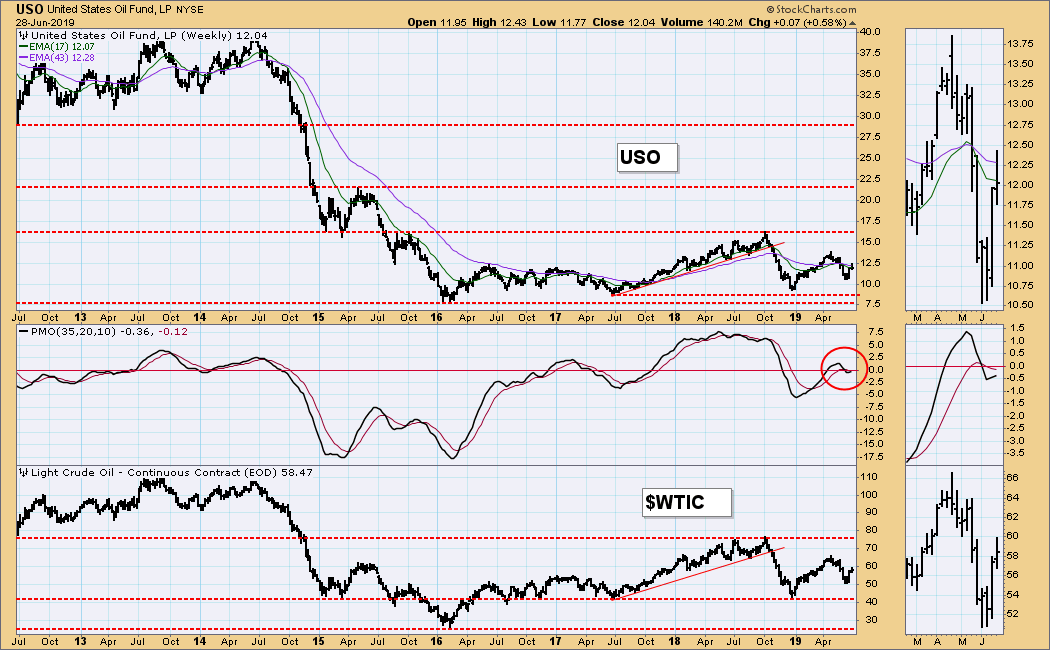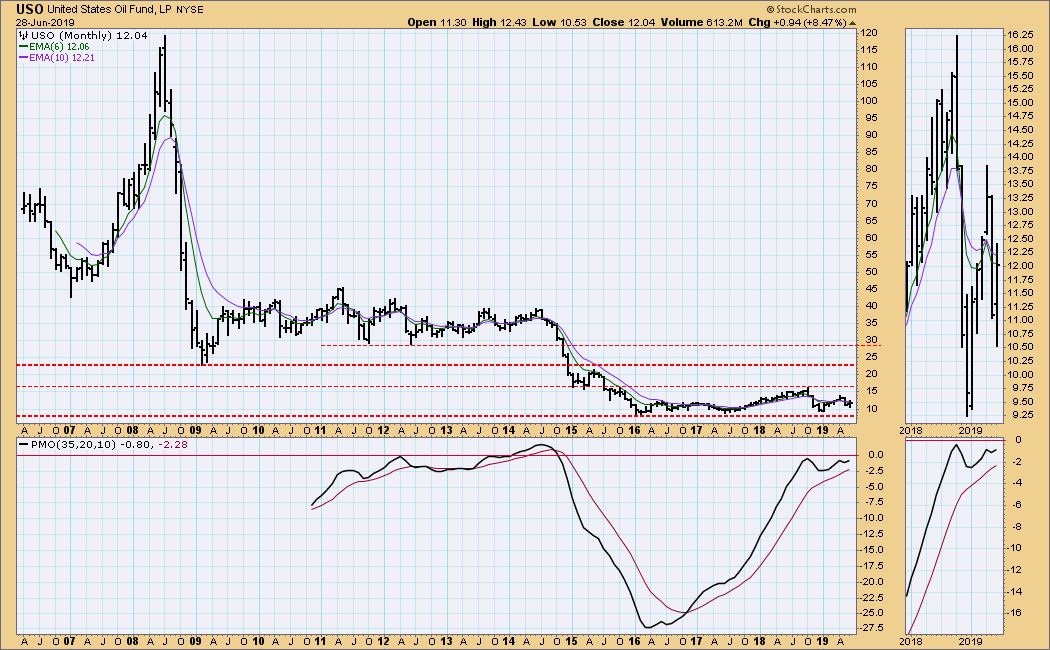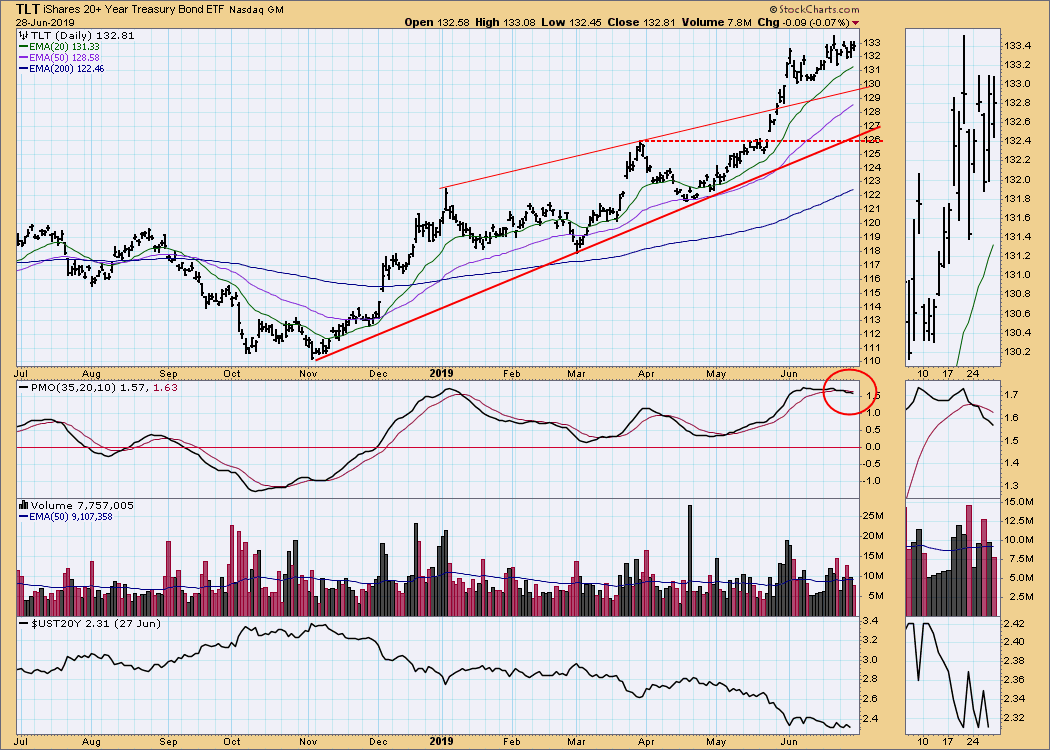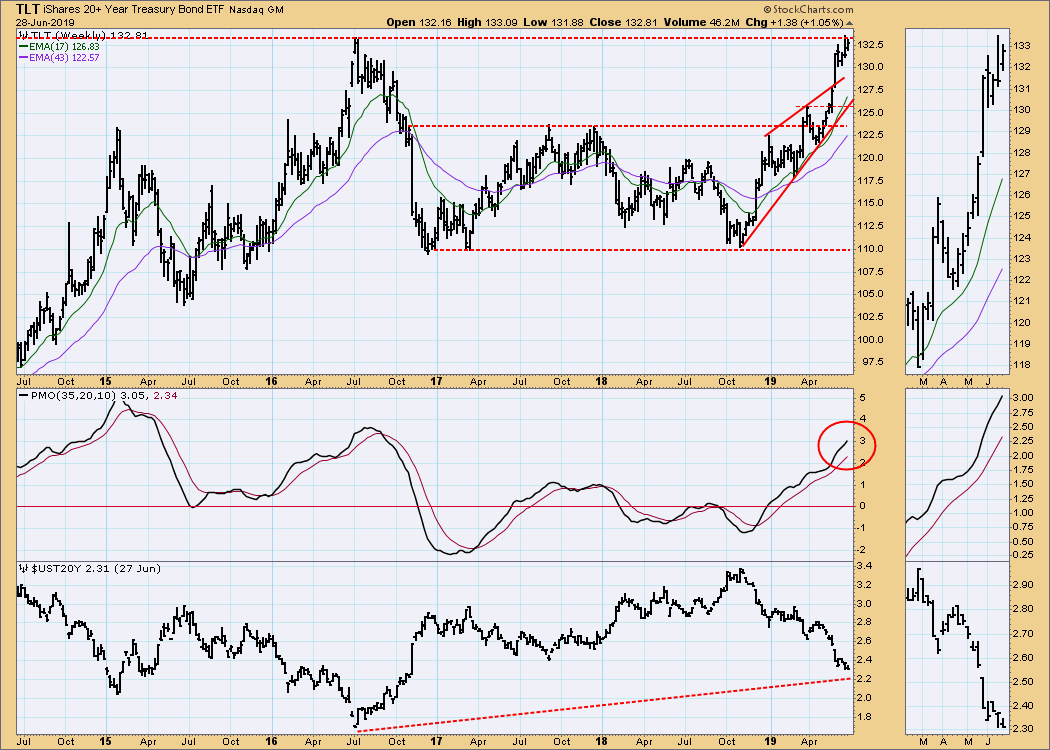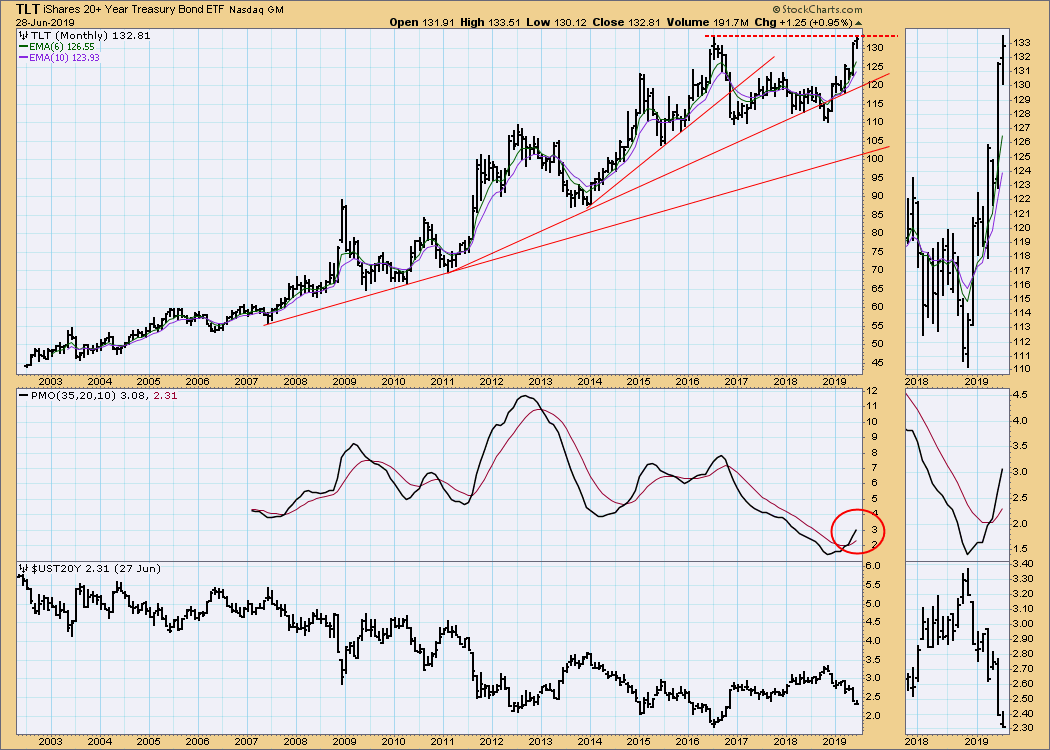
So much of the time it seems we are waiting for some event that will determine what the market is going to do next. Last week it was waiting for the Fed. This week it was waiting for the meeting between President Trump and President Xi tomorrow. What the market will do next depends on that meeting, but we can't know what will come of that meeting. We can, however, make an educated guess. Based upon what I have been hearing, the U.S. and China are still quite far apart in the negotiations, so it seems highly unlikely that an agreement will be reached tomorrow, or even next week, so my guess is that nothing substantive will be announced this weekend, or in the coming weeks. I will be astounded if I'm wrong about that. As to what the market might do, I think that Friday's volume spike gives us a clue about that. I'll address that in the discussion below.
The DecisionPoint Weekly Wrap presents an end-of-week assessment of the trend and condition of the stock market (S&P 500), the U.S. Dollar, Gold, Crude Oil, and Bonds.
Watch the latest episode of DecisionPoint on StockCharts TV's YouTube channel here!
GLOBAL MARKETS
BROAD MARKET INDEXES
SECTORS
Each S&P 500 Index component stock is assigned to one, and only one, of 11 major sectors. This is a snapshot of the Intermediate-Term and Long-Term Trend Model signal status for those sectors.

INTEREST RATES
Because interest rates are currently inverted, I will be including a chart so we can watch the situation. In normal circumstances the longer money is borrowed, the higher the interest rate that must be paid. When rates are inverted, the reverse is true. It is generally believed that rate inversions result from "a flight to safety." On the chart below, notice that the one-month and three month T-Bills (dotted lines) pay a higher interest rate than the one year through the 10-year T-Bonds. This is a serious problem for the stock market.
STOCKS
IT Trend Model: BUY as of 6/11/2019
LT Trend Model: BUY as of 2/26/2019
SPY Daily Chart: We have had over three weeks of low SPX total volume market action (even options expiration volume last week was very low). Then on Friday we get a total volume spike that is huge by comparison. This could mean a lot of things, but my guess is that it is caused by traders getting flat the market ahead of what will probably negative trade news.
SPY Weekly Chart: The weekly PMO is positive and rising. Bullish.
SPY Monthly Chart: After turning down in May, the monthly PMO turned up again. Bullish.
Climactic Market Indicators: On the StockCharts TV DecisionPoint show this afternoon Erin and I had a discussion as to whether or not there was an initiation climax or an exhaustion climax today. There are really only two climactic readings (Net Breadth and Total Volume), and I have to exclude volume because of why I think it was so high. So no climax.
Short-Term Market Indicators: The negative divergences from last week are still a problem.
Intermediate-Term Market Indicators: Every one of these indicators are rising, so there is a problem with the perceived negative divergences.
CONCLUSION: There are two major fundamental issues weighing on the market: (1) With a P/E of 22, the market is very overvalued; and (2) the yield curve is inverted. We can't necessarily time technical decisions based upon this, but these issues must be considered as an important backdrop.
Technically, the market appears to be poised to move substantially higher, but breaking news could put a plug quickly in that jug. Everything seems to hang on the China trade deal, but China is Communist and its leaders don't have to be re-elected. They can play the long game and wait for a new, more pliable POTUS to deal with in 2020. Even if they decide to make a deal, IMHO it won't happen this weekend. And that's why I'm interpreting Friday's high volume as traders getting flat ahead of the news. I could be wrong, but that's the best I've got.
DOLLAR (UUP)
IT Trend Model: BUY as of 2/7/2019
LT Trend Model: BUY as of 5/25/2018
UUP Daily Chart: There are a number of points of interest on this chart -- all bearish: (1) The rising trend line has been violated; (2) a head and shoulders neckline has been violated; and (3) a bearish reverse flag has formed. I didn't all of these points on the chart, but I think you can see them easily. The daily PMO is oversold based upon the one-year range, but I think that range will break down.
UUP Weekly Chart: In this time frame it is obvious that price has been turned back by long-term overhead resistance. The weekly PMO is creeping down out of the one-year consolidation.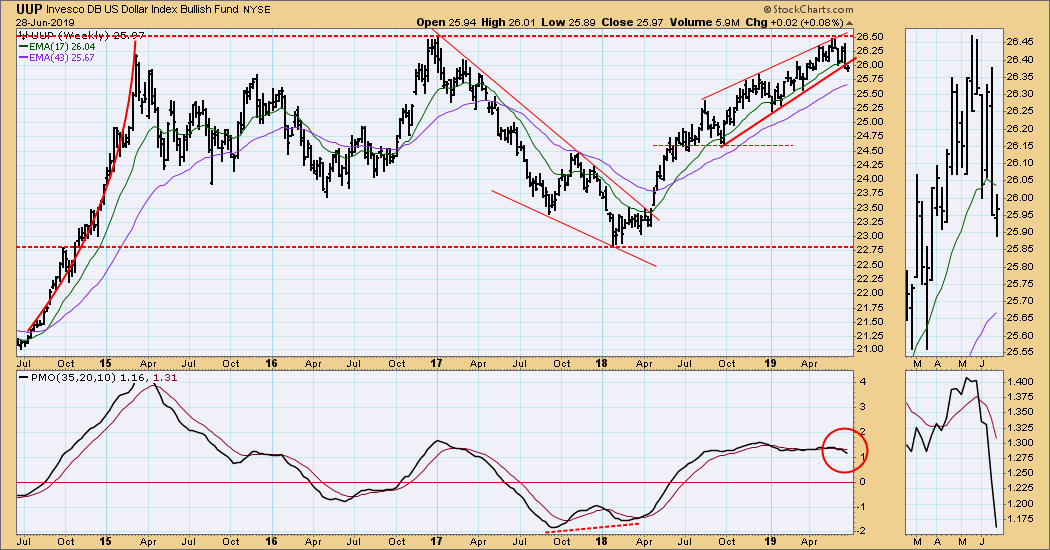
UUP Monthly Chart: The resistance seen on the weekly chart goes all the way back to 2008, and the monthly PMO is trying to top, so my assumption at this point is that price will be declining for a while. This is good news for gold.
GOLD
IT Trend Model: BUY as of 6/3/2019
LT Trend Model: BUY as of 1/8/2019
GOLD Daily Chart: Gold moved up almost +7% after the breakout above the resistance line drawn across the February top. The daily PMO is overbought based upon PMO levels of the last 10 years.
GOLD Weekly Chart: The longer-term resistance line was also overcome by almost +5%. The weekly PMO is overbought based upon its normal range, but it could easily move higher without challenging credibility if gold continues to rally.
GOLD Monthly Chart: I think this chart looks bullish, but I wouldn't rule out gold continuing to tease to the downside. For example, in my June 14 blog I proposed that gold might put a handle on the saucer formation. Upon reflection, it occurs to me that, in the process of forming the handle, gold could chop above and below the support/resistance line, keeping the bulls nervous and the bears happy. Ultimately, I think the bulls will win.
CRUDE OIL (USO)
IT Trend Model: NEUTRAL as of 5/30/2019
LT Trend Model: SELL as of 6/4/2019
USO Daily Chart: In its move up USO has produced gaps that more or less correspond to the gaps it made coming down. The daily PMO allows for higher prices, but I think the April top is probably the upside limit, unless news becomes more threatening.
USO Weekly Chart: The USO weekly PMO allows for a move higher, and the three-year range for crude implies a potential upside of $76.
USO Monthly Chart: The monthly PMO is about neutral, and it offers no encouragement to bulls.
BONDS (TLT)
IT Trend Model: BUY as of 12/6/2018
LT Trend Model: BUY as of 1/2/2019
TLT Daily Chart: Price is playing with new highs, but the PMO is at the overbought side of the one-year range. I have added a panel to these charts showing the 20-Year US Treasury Yield. We usually think of the bond price and the yield being reciprocal, but that is not always the case. At any rate, I think we will learn something by keeping an eye on this.
TLT Weekly Chart: While TLT has hit a line of resistance drawn across the 2016 high, note that the yield is well above its 2016 low. For now I'm going to assume that means, with the potential for lower yield, there is a potential for higher bond prices. The weekly PMO is overbought, but it still has room to go higher in the five-year range shown.
TLT Monthly Chart: The monthly PMO is coming off a 13-year low, and it allows for prices to move higher.
**Don't miss any of the DecisionPoint commentaries! Go to the "Notify Me" box toward the end of this blog page to be notified as soon as they are published.**
Technical Analysis is a windsock, not a crystal ball.
Happy Charting!
- Carl
NOTE: The signal status reported herein is based upon mechanical trading model signals, specifically, the DecisionPoint Trend Model. They define the implied bias of the price index based upon moving average relationships, but they do not necessarily call for a specific action. They are information flags that should prompt chart review. Further, they do not call for continuous buying or selling during the life of the signal. For example, a BUY signal will probably (but not necessarily) return the best results if action is taken soon after the signal is generated. Additional opportunities for buying may be found as price zigzags higher, but the trader must look for optimum entry points. Conversely, exit points to preserve gains (or minimize losses) may be evident before the model mechanically closes the signal.
Helpful DecisionPoint Links:
DecisionPoint Shared ChartList and DecisionPoint Chart Gallery
Price Momentum Oscillator (PMO)
Swenlin Trading Oscillators (STO-B and STO-V)

